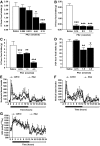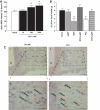Prokineticin 2 is a hypothalamic neuropeptide that potently inhibits food intake
- PMID: 19933997
- PMCID: PMC2809973
- DOI: 10.2337/db09-1198
Prokineticin 2 is a hypothalamic neuropeptide that potently inhibits food intake
Abstract
Objective: Prokineticin 2 (PK2) is a hypothalamic neuropeptide expressed in central nervous system areas known to be involved in food intake. We therefore hypothesized that PK2 plays a role in energy homeostasis.
Research design and methods: We investigated the effect of nutritional status on hypothalamic PK2 expression and effects of PK2 on the regulation of food intake by intracerebroventricular (ICV) injection of PK2 and anti-PK2 antibody. Subsequently, we investigated the potential mechanism of action by determining sites of neuronal activation after ICV injection of PK2, the hypothalamic site of action of PK2, and interaction between PK2 and other hypothalamic neuropeptides regulating energy homeostasis. To investigate PK2's potential as a therapeutic target, we investigated the effect of chronic administration in lean and obese mice.
Results: Hypothalamic PK2 expression was reduced by fasting. ICV administration of PK2 to rats potently inhibited food intake, whereas anti-PK2 antibody increased food intake, suggesting that PK2 is an anorectic neuropeptide. ICV administration of PK2 increased c-fos expression in proopiomelanocortin neurons of the arcuate nucleus (ARC) of the hypothalamus. In keeping with this, PK2 administration into the ARC reduced food intake and PK2 increased the release of alpha-melanocyte-stimulating hormone (alpha-MSH) from ex vivo hypothalamic explants. In addition, ICV coadministration of the alpha-MSH antagonist agouti-related peptide blocked the anorexigenic effects of PK2. Chronic peripheral administration of PK2 reduced food and body weight in lean and obese mice.
Conclusions: This is the first report showing that PK2 has a role in appetite regulation and its anorectic effect is mediated partly via the melanocortin system.
Figures







Similar articles
-
Changes in the responsiveness of hypothalamic prokineticin 2 mRNA expression to food deprivation in developing female rats.Int J Dev Neurosci. 2014 May;34:76-8. doi: 10.1016/j.ijdevneu.2014.02.001. Epub 2014 Feb 18. Int J Dev Neurosci. 2014. PMID: 24560704
-
Peripheral administration of prokineticin 2 potently reduces food intake and body weight in mice via the brainstem.Br J Pharmacol. 2013 Jan;168(2):403-10. doi: 10.1111/j.1476-5381.2012.02191.x. Br J Pharmacol. 2013. PMID: 22935107 Free PMC article.
-
Activation of amygdala prokineticin receptor 2 neurons drives the anorexigenic activity of the neuropeptide PK2.J Biol Chem. 2023 Jan;299(1):102814. doi: 10.1016/j.jbc.2022.102814. Epub 2022 Dec 17. J Biol Chem. 2023. PMID: 36539034 Free PMC article.
-
The hypothalamus and the regulation of energy homeostasis: lifting the lid on a black box.Proc Nutr Soc. 2000 Aug;59(3):385-96. doi: 10.1017/s0029665100000434. Proc Nutr Soc. 2000. PMID: 10997654 Review.
-
Neuropeptides and obesity.Nutrition. 2000 Oct;16(10):916-23. doi: 10.1016/s0899-9007(00)00410-x. Nutrition. 2000. PMID: 11054597 Review.
Cited by
-
The balance of concentration between Prokineticin 2β and Prokineticin 2 modulates the food intake by STAT3 signaling.BBA Adv. 2021 Oct 14;1:100028. doi: 10.1016/j.bbadva.2021.100028. eCollection 2021. BBA Adv. 2021. PMID: 37082024 Free PMC article.
-
MRAP2a Binds and Modulates Activity and Localisation of Prokineticin Receptor 1 in Zebrafish.Int J Mol Sci. 2024 Jul 17;25(14):7816. doi: 10.3390/ijms25147816. Int J Mol Sci. 2024. PMID: 39063058 Free PMC article.
-
Intracerebroventricular PROK2 infusion could increase the secretion of male reproductive hormones by stimulating the HPG axis.Mol Biol Rep. 2024 May 13;51(1):656. doi: 10.1007/s11033-024-09604-4. Mol Biol Rep. 2024. PMID: 38740671
-
An ancient founder mutation in PROKR2 impairs human reproduction.Hum Mol Genet. 2012 Oct 1;21(19):4314-24. doi: 10.1093/hmg/dds264. Epub 2012 Jul 5. Hum Mol Genet. 2012. PMID: 22773735 Free PMC article.
-
Phenotypic and genotypic landscape of PROKR2 in neuroendocrine disorders.Front Endocrinol (Lausanne). 2023 Feb 8;14:1132787. doi: 10.3389/fendo.2023.1132787. eCollection 2023. Front Endocrinol (Lausanne). 2023. PMID: 36843573 Free PMC article. Review.
References
-
- Wechselberger C, Puglisi R, Engel E, Lepperdinger G, Boitani C, Kreil G: The mammalian homologues of frog Bv8 are mainly expressed in spermatocytes. FEBS Lett 1999;462:177–181 - PubMed
-
- Li M, Bullock CM, Knauer DJ, Ehlert FJ, Zhou QY: Identification of two prokineticin cDNAs: recombinant proteins potently contract gastrointestinal smooth muscle. Mol Pharmacol 2001;59:692–698 - PubMed
-
- LeCouter J, Kowalski J, Foster J, Hass P, Zhang Z, Dillard-Telm L, Frantz G, Rangell L, DeGuzman L, Keller GA, Peale F, Gurney A, Hillan KJ, Ferrara N: Identification of an angiogenic mitogen selective for endocrine gland endothelium. Nature 2001;412:877–884 - PubMed
-
- Lin DC, Bullock CM, Ehlert FJ, Chen JL, Tian H, Zhou QY: Identification and molecular characterization of two closely related G protein-coupled receptors activated by prokineticins/endocrine gland vascular endothelial growth factor. J Biol Chem 2002;277:19276–19280 - PubMed
-
- Masuda Y, Takatsu Y, Terao Y, Kumano S, Ishibashi Y, Suenaga M, Abe M, Fukusumi S, Watanabe T, Shintani Y, Yamada T, Hinuma S, Inatomi N, Ohtaki T, Onda H, Fujino M: Isolation and identification of EG-VEGF/prokineticins as cognate ligands for two orphan G-protein-coupled receptors. Biochem Biophys Res Commun 2002;293:396–402 - PubMed
Publication types
MeSH terms
Substances
Grants and funding
- WT_/Wellcome Trust/United Kingdom
- G0700495/MRC_/Medical Research Council/United Kingdom
- BB/D525064/1/BB_/Biotechnology and Biological Sciences Research Council/United Kingdom
- BB/F021704/1/BB_/Biotechnology and Biological Sciences Research Council/United Kingdom
- BB/E021972/1/BB_/Biotechnology and Biological Sciences Research Council/United Kingdom
LinkOut - more resources
Full Text Sources
Other Literature Sources
Medical

